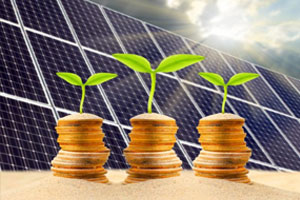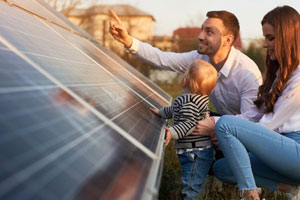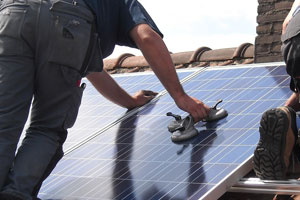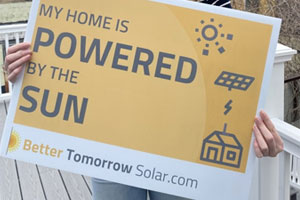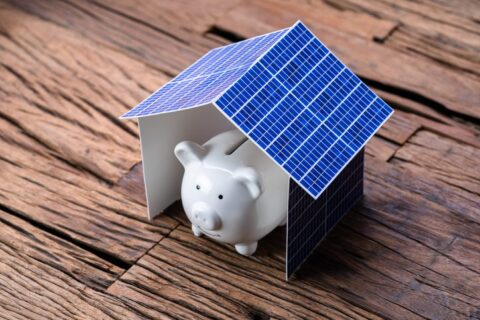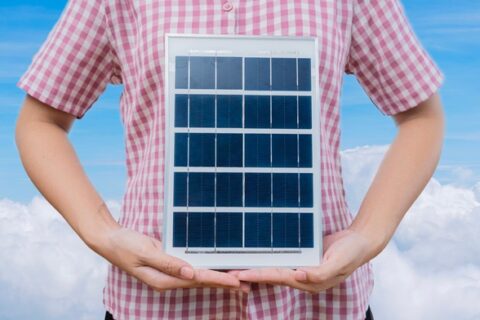Does Solar Energy Save You Money?
As with any home improvement project, homeowners often will want to know the money-saving potential of the project. For a solar project the answer is yes…and no. Yes, you will save money in the long-term. No, you will get the financial investment immediately.
However, when you compare other investments in your home, the benefits of an investment in solar are huge as compared to similar investments in an updated kitchen or bathroom. Currently, when solar is installed on your home you get a 26% federal tax credit. Often times there is a rebate or buyback program with your local utility (check with your installer or local utility to know what you are eligible for) and when it is time to sell your home, there is a growing body of evidence showing that solar on the roof both will increase your home value and shorten the days it stays on the market. Homebuyers want to solarized homes and are willing to pay more for that preference. As the energy cost of living in a solarized house is less, more banks are willing to lend more to buyers of such homes.
There are of course direct and immediate benefits to installing solar. The most obvious of those benefits is, of course, savings on your electric bills. In fact, you will see savings every month! Depending on when your solar installation goes “live” with your local utility you could see huge savings. Solar systems that activate during summer months reap the benefit of longer daytime production, stronger sunshine, and offsetting of higher rates. Winter months see less production but still see cost savings. Solar companies often provide energy monitoring with their installation, which can track your savings and display them in all sorts of colorful charts and graphs.
A solar owner once discussed the joy of knowing he had solar on his home. He understood the value of solar. He knew that the panels he purchased would financially be offset after 8 to 10 years, but the excitement of showing visitors his new prize possession gave him a personal story of benefit. He shared reducing his reliance on grid electricity, creating a better future for his child and future generations, and the long-term gain of providing financial resiliency as solar after the payback period would produce free energy for his home for years much longer than the payback time. Can you put a price on the uncalculated benefits of solar? In his mind, no. His exuberance of owning solar absolutely could not be contained.
How does solar energy meet your family’s needs?
It is hard to imagine our modern lifestyle without consuming some form of energy. We use highly refined gasoline in our cars, gas or oil to heat up our houses and cook our meals, and electricity to light our homes at night. All our energy needs can be met with one form of energy: electricity. Electricity can power our cars, heat our homes, and cook our meals. But is there a benefit to using only electricity for all our energy needs? The answer is a resounding yes. There are many benefits to electrifying as much as we can.
How does solar energy work for homeowners?
Before we discuss the merits of electricity over other forms of energy, it is important to bear in mind that all electricity, regardless of how it is generated, is the same. Whether generated by dirty coal, heat-trapping natural gas, radioactive waste-producing nuclear fission, or the gap between silicon wafers in a solar panel, the movement of electrons in a circuit is the same. Its magnitude will vary, but its quality is the same. Your appliances or electric motors will not care how that electricity is produced. They will operate the same.
Electric energy is the future of energy consumption
Did you know that by merely electrifying everything (transportation, heating, cooking, etc.), we would save forty percent of our carbon emissions? That reduction can be achieved without any conservation measures whatsoever: no reduction in car sizes or speeds; no setting of thermostats lower in the winter or higher in the summer; no change whatsoever in our lifestyles. If we only use electricity for our energy consumption, drive electric cars, and use heat pumps, for example, we will reduce our carbon emissions by 40%. Electrification makes a lot of sense. So not only is solar the future of electricity, but electricity is, or ought to be, the future of all energy consumption.
Conservation measures are estimated to save another 5 to 25% on top of that. Many of those conservation measures do not reduce our comfort level in any way. Insulating our buildings better, converting to LED lighting, and programming thermostats to turn off the air conditioning system when no one is in the building are but a few such examples. So the world’s carbon emissions can be reduced by up to 65% without affecting our day-to-day behavior or any sacrifice at all.
Keep in mind that the calculation is done with today’s often dirty mix of electric production. As solar achieves a greater share of electric production, the savings in carbon emissions will be greater. Solar and wind (with storage), and to a lesser extent other renewables, can close the remaining 35% gap to achieve fully carbon-free energy without any sacrifice or change in our behavior.
Solar energy is the future of electricity
In the early days of solar energy, many doubted that solar energy would have much of a role in our energy future. Maybe, they maintained, it could shave a little off the peak demand on sunny afternoons. Solar did not seem to be a viable option. If solar could provide a percent or two of our total energy needs, that would be sufficient.
Things have changed. Solar is now the least costly form of energy. That is counting only the energy production costs. When you think of cleanup costs (think of coal ash clean up and storage of radioactive waste management and storage, both of which last for a very long time), the cost of solar does not compare to the cost of coal and nuclear. When you add the cost of lung disease and cancer of course the cost comparisons mean little. The only form of energy that comes close to the cost of solar is natural gas. For those costs to be close, you have to disregard natural gas’s two major associated costs: carbon mitigation and environmental remediation and cleanup of fracking sites.
With solar costs going down and the wider understanding of solar’s environmental benefits, little doubt remains that early critics of solar were wrong. Solar is the future of electricity.
Solar can generate energy without the pollution of fossil fuels
The only difference between producing electricity with solar panels versus the other forms of production is that with solar there is no harmful byproduct left over. Absolutely no harmful toxins are created or released. This is an unintended benefit of solar. No toxic byproducts or mitigation is needed with solar energy production.
Why does solar energy work as an investment?
The cost of solar energy is lower than power bought off the grid. To correctly compare the costs you have to levelized the costs. That is done by adding up all the power a solar array will generate over its lifetime and dividing that by the cost of the solar system itself. The levelized cost of one kilowatt of electricity produced by the sun is now about one-third of a kilowatt purchase from a utility company. That is at today’s average price. Add to that the fact that the price of grid-purchased power is likely to increase over the lifetime of your solar array, while the price of sunshine will certainly remain constant at zero. So the levelized price of solar power will likely be even less than one-third. What will you and your family do with the two-thirds or more that you will save on your power bill every month over the next 25 to 35 years?
How does solar energy help your community?
Many people do not understand how the electric grid works. When solar is added to the electric grid from your home it does not go back to the central location. Instead, solar travels along electricity lines and the next person who needs electricity is usually your neighbor. So that means your neighbor becomes a solar consumer! When your neighbor consumes solar energy generated from your roof, he or she will not be consuming dirty grid power generated by the central power station. How cool is that?
Putting clean energy is not the only community benefit. The more solar that is produced locally means less fossil fuel is needed to produce energy in your local community. If you care about the well-being of the residents of your town, city, or county, then getting solar means you are protecting the health of local children, those who have sensitivities caused by air pollution like asthma and other breathing conditions, and even the elderly. According to a recent study, 14% of all cardiovascular events and more than 8% of all cardiovascular deaths globally are directly attributable to air pollution.
Additionally, you are protecting people who currently live near fossil fuel electricity plants. Whether it is a coal-fired plant or a natural gas transfer station, the residents of those communities deal with all kinds of environmental pollution issues. Coal plants generate tons of coal ash which in turn creates ash ponds that if un-lined leach at least 8 heavy metals into the groundwater. These heavy metals include arsenic, mercury, lead, cadmium, chromium, and selenium. Many communities located near coal ash waste have clusters of cancer and asthma.
So, what is wrong with natural gas? Although lower in carbon, natural gas is still a carbon-burning fuel. It contains methane which is 80 times worse than carbon dioxide in terms of its effect on climate change. If you care about the atmosphere and a stable climate, then you need to care about methane. To make matters worse methane is the number one pollutant that leaks when transferring natural gas. Methane is the most common part of natural gas and therefore when transported in a pipeline across the country it is the biggest pollutant of natural gas. Natural gas goes through a series of transfer stations to reach the point at which it is burned. At every transfer station, there is an opportunity for methane and other natural gas components to leak. The severity of the problem necessitates a whole federal regulatory system known as NAAQS (National Ambient Air Quality Standards*) that manages and monitors the transfer of natural gas among other air pollutants.
How does solar energy benefit businesses?
Electric power generated from the sun will work and benefit a business in the same way it does a home. Businesses of course will benefit from the same lower levelized cost of power generated by the sun. But there are several additional benefits for businesses.
Being able to predict costs is important to budgeting and planning. The cost of fuel for solar power is rigidly stabilized at zero. The operation and maintenance costs of solar systems are low and predictable. So solar offers businesses additional benefits in terms of allowing for more accurate budgeting and planning of their energy costs.
Another benefit has to do with healthcare costs, the burden of which, in our current system, falls directly on businesses. The growth of renewable energy, including solar power, will lead to a healthier population in the long term. Therefore, the healthcare cost burden on business will be reduced with the growth of clean, renewable energy.
* National Ambient Air Quality Standards (NAAQS) –The standards are normally associated with car pollution but include many other forms of air pollution.



